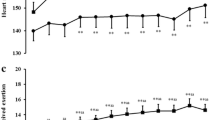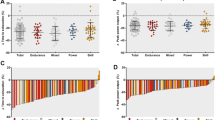Abstract
Purpose
We determined the effects of different environmental temperatures on exercise-induced gastrointestinal (GI) damage and delayed gastric emptying (GE) rate.
Methods
Eleven trained males completed three trials on different days, consisting of (1) exercise in a thermoneutral environment (CON, 23 °C), (2) exercise in a hot environment (HOT, 35 °C), and (3) exercise in a cold environment (COLD, 10 °C). The subjects performed high-intensity interval-type endurance exercises in all trials. Blood intestinal fatty acid binding protein (I-FABP) levels was determine before and after exercise. We evaluated Tmax (time when the 13C-excretion/h reached a maximum level) as an indication of the GE rate during post-exercise.
Results
Rectal temperature during exercise was significantly higher (P < 0.001) in the HOT (38.7 ± 0.3 °C) trial compared with the CON (38.2 ± 0.3 °C) and COLD (38.2 ± 0.3 °C) trials, with no significant difference between the CON and COLD trials. Plasma I-FABP level after exercise (relative to the pre-exercise level) were significantly greater (P = 0.005) in the HOT trial (92.9 ± 69.6%) than in the CON (37.2 ± 31.6%) and COLD (37.6 ± 41.8%) trials. However, there was no significant difference between the CON and COLD trials. Moreover, the Tmax was delayed significantly (P = 0.006) in the HOT trial compared with the CON and COLD trials, with no significant difference between the CON and COLD trials.
Conclusion
GI function following endurance exercise was similar between thermoneutral and cold environments, while endurance exercise in a hot environment exacerbated GI function compared with thermoneutral and cold environments.


Similar content being viewed by others
Data availability
The data presented in this study are available on request from the corresponding author. The data are not publicly available due to ethical restrictions.
Abbreviations
- ANOVA:
-
Analysis of variance
- 12CO2 :
-
12C-labeled carbon dioxide output
- 13CO2 :
-
13C-labeled carbon dioxide output
- COLD:
-
Endurance exercise in a cold environment
- CON:
-
Endurance exercise in a thermoneutral environment
- ELISA:
-
Enzyme-linked immune sorbent assay
- GE:
-
Gastric emptying
- GI:
-
Gastrointestinal
- HA:
-
Heat acclimation
- Hb:
-
Hemoglobin
- Hct:
-
Hematocrit
- HOT:
-
Endurance exercise in a hot environment
- HR:
-
Heart rate
- HST:
-
Heat stress test
- I-FABP:
-
Intestinal fatty acid binding protein
- PV:
-
Plasma volume
- RH:
-
Relative humidity
- RPE:
-
Rate of perceived exertion
- SD:
-
Standard deviations
- Trec :
-
Rectal temperature
- Tmax :
-
Time when the 13C-excretion/h reached a maximum
- TS:
-
Thermal sensation
- Tsk :
-
Skin temperature
- \({\dot{\text{V}O}}_{{\text{2max}}}\) :
-
Maximal oxygen uptake
References
Braden B, Adams S, Duan LP et al (1995) The [13C] acetate breath test accurately reflects gastric emptying of liquids in both liquid and semisolid test meals. Gastroenterology 108:1048–1055
Brouns F (1991) Etiology of gastrointestinal disturbances during endurance events. Scand J Med Sci Sports 1:66–77
Cammack J, Read NW, Cann PA, Greenwood B, Holgate AM (1982) Effect of prolonged exercise on the passage of a solid meal through the stomach and small intestine. Gut 23:957–961
Castellani JW, Tipton MJ (2015) Cold stress effects on exposure tolerance and exercise performance. Compr Physiol 6(1):443–469
Castellani JW, Young AJ (2016) Human physiological responses to cold exposure: acute responses and acclimatization to prolonged exposure. Auton Neurosci 196:63–74
Chantler S, Griffiths A, Matu J, Davison G, Jones B, Deighton K (2021) The effects of exercise on indirect markers of gut damage and permeability: a systematic review and meta-analysis. Sports Med 51(1):113–124
Costa RJS, Snipe RMJ, Kitic CM, Gibson PR (2017) Systematic review: exercise-induced gastrointestinal syndrome—implications for health and intestinal disease. Aliment Pharmacol Ther 46:246–265
Dill DB, Costill DL (1974) Calculation of percentage changes in volumes of blood, plasma, and red cells in dehydration. J Appl Physiol 37:247–248
Du Bois D, Du Bois EF (1917) A formula to estimate the approximate surface area if height and weight be known. Arch Intern Med 17:863–871
Galloway S, Maughan R (1997) Effects of ambient temperature on the capacity to perform prolonged cycle exercise in man. Med Sci Sports Exerc 29(9):1240–1249
Ghoos YF, Maes BD, Geypens BJ et al (1993) Measurement of gastric emptying rate of solids by means of a carbon- labeled octanoic acid breath test. Gastroenterology 104:1640–1647
Horner KM, Schubert MM, Desbrow B, Byrne NM, King NA (2015) Acute exercise and gastric emptying: a meta-analysis and implications for appetite control. Sports Med 45(5):659–678
Houmard JA, Egan PC, Johns RA, Neufer PD, Chenier TC, Israel RG (1991) Gastric emptying during 1 h of cycling and running at 75 % VO2max. Med Sci Sports Exerc 23(3):320–325
Kashima H, Harada N, Miyamoto K et al (2017) Timing of postexercise carbohydrate-protein supplementation: roles of gastrointestinal blood flow and mucosal cell damage on gastric emptying in humans. J Appl Physiol 123(3):606–613
Kashima H, Sugimura K, Taniyawa K et al (2018) Timing of post-resistance exercise nutrient ingestion: Effects on gastric emptying and glucose and amino acid responses in humans. Br J Nutr 120:995–1005
Kenney WL, Ho CW (1995) Age alters regional distribution of blood flow during moderate-intensity exercise. J Appl Physiol 79(4):1112–1119
Leiper JB, Broad NP, Maughan RJ (2001) Effect of intermittent high-intensity exercise on gastric emptying in man. Med Sci Sports Exerc 33(8):1270–1278
Neufer PD, Costill DL, Fink WJ, Kirwan JP, Fielding RA, Flynn MG (1986) Effects of exercise and carbohydrate composition on gastric emptying. Med Sci Sports Exerc 18(6):658–662
Neufer PD, Young AJ, Sawka MN (1989a) Gastric emptying during exercise: effects of heat stress and hypohydration. Eur J Appl Physiol Occup Physiol 58(4):433–439
Neufer PD, Young AJ, Sawka MN (1989b) Gastric emptying during walking and running: effects of varied exercise intensity. Eur J Appl Physiol Occup Physiol 58:440–445
Osborne JO, Stewart IB, Beagley KW, Minett GM (2019) The effect of cycling in the heat on gastrointestinal-induced damage and neuromuscular fatigue. Eur J Appl Physiol 119(8):1829–1840
Ramanathan NL (1964) A new weighting system for mean surface temperature of the human body. J Appl Physiol 19:531–533
Snipe RMJ, Khoo A, Kitic CM, Gibson PR, Costa RJS (2018a) The impact of mild heat stress during prolonged running on gastrointestinal integrity, gastrointestinal symptoms, systemic endotoxin and cytokine profiles. Int J Sports Med 39:255–263
Snipe RMJ, Khoo A, Kitic CM, Gibson PR, Costa RJS (2018b) The impact of exertional-heat stress on gastrointestinal integrity, gastrointestinal symptoms, systemic endotoxin and cytokine profile. Eur J Appl Physiol 118(2):389–400
Van Houten JM, Wessells RJ, Lujan HL, DiCarlo SE (2015) My gut feeling says rest: increased intestinal permeability contributes to chronic diseases in high-intensity exercisers. Med Hypotheses 85:882–886
van Wijck K, Lenaerts K, van Loon LJC, Peters WHM, Buurman WA, Dejong CHC (2011) Exercise-Induced splanchnic hypoperfusion results in gut dysfunction in healthy men. PLoS ONE 6:e22366
van Wijck K, Lenaerts K, Grootjans J et al (2012a) Physiology and pathophysiology of splanchnic hypoperfusion and intestinal injury during exercise: strategies for evaluation and prevention. Am J Physiol Gastrointest Liver Physiol 303:G155-168
van Wijck K, Lenaerts K, Van Bijnen AA et al (2012b) Aggravation of exercise-induced intestinal injury by ibuprofen in athletes. Med Sci Sports Exerc 44:2257–2262
van Wijck K, Pennings B, van Bijnen AA et al (2013) Dietary protein digestion and absorption are impaired during acute post-exercise recovery in young men. Am J Physiol Regul Integr Comp Physiol 304:R356-361
Wendt D, van Loon LJ, Lichtenbelt WD (2007) Thermoregulation during exercise in the heat: strategies for maintaining health and performance. Sports Med 37(8):669–682
Wilson RC, Jones PW (1991) Long-term reproducibility of Borg scale estimates of breathlessness during exercise. Clin Sci 80:309–312
Yeh YJ, Law LYL, Lim CL (2013) Gastrointestinal response and endotoxemia during intense exercise in hot and cool environments. Eur J Appl Physiol 113(6):1575–1583
Zhang H, Huizenga C, Arens E, Wang D (2004) Thermal sensation and comfort in transient non-uniform thermal environments. Eur J Appl Physiol 92:728–733
Acknowledgements
We would like to appreciate all participants who completed experimental trials. We also thank the laboratory members for the grateful technical support. The present study was supported by a Grant-in-Aid for Scientific Research from the Japan Society for the Promotion of Science.
Funding
This study was supported by Grant-in-Aid for Scientific Research from Japan Society for the Promotion of Science (20J01920).
Author information
Authors and Affiliations
Contributions
DS contributed to the study design, data collection, analysis, and manuscript writing. KO contributed to the study design, data interpretation and manuscript preparation. KG contributed to the study design, data collection, analysis, and manuscript writing. All authors read and approved the final manuscript.
Corresponding author
Ethics declarations
Conflict of interest
The authors declare that they have no conflict of interest.
Additional information
Communicated by Michael I Lindinger.
Publisher's Note
Springer Nature remains neutral with regard to jurisdictional claims in published maps and institutional affiliations.
Rights and permissions
Springer Nature or its licensor (e.g. a society or other partner) holds exclusive rights to this article under a publishing agreement with the author(s) or other rightsholder(s); author self-archiving of the accepted manuscript version of this article is solely governed by the terms of such publishing agreement and applicable law.
About this article
Cite this article
Sumi, D., Okazaki, K. & Goto, K. Gastrointestinal function following endurance exercise under different environmental temperatures. Eur J Appl Physiol (2024). https://doi.org/10.1007/s00421-023-05387-x
Received:
Accepted:
Published:
DOI: https://doi.org/10.1007/s00421-023-05387-x




